Unraveling the Secrets through Science
CHO Sangsun
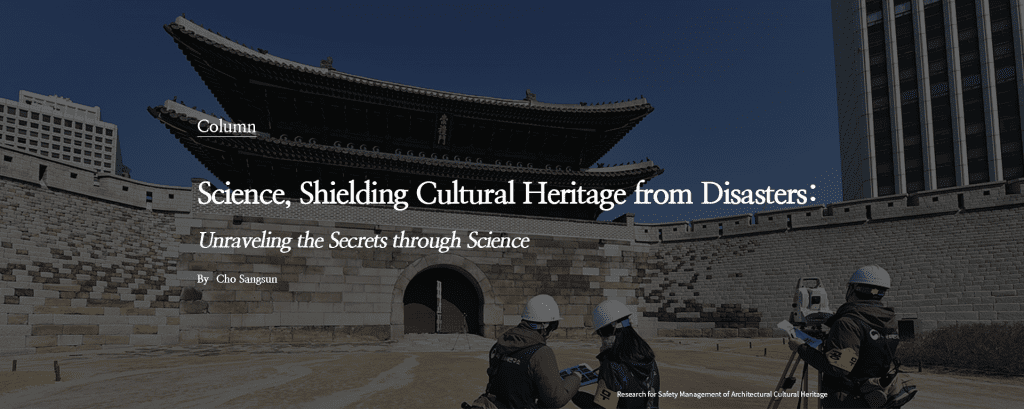

The earthquakes that occurred in North Gyeongsang Province during 2016–2017 served as a reminder to the Korean people that Korea is not safe from natural disasters such as earthquakes. Indeed, throughout history, there have been a fair number of earthquakes in the Korean Peninsula. For instance, in 1936, a major earthquake rattled the Jirisan Mountain region. Then in 1978, a magnitude 5.0 earthquake also shook Hongseong, South Chungcheong Province. Historical documents, including Joseon wangjo sillok (The Annals of the Joseon Dynasty) and Samguk yusa (Memorabilia of the Three Kingdoms), also mention more than 2,000 earthquakes. One fascinating record revealed that an earthquake with a presumed magnitude of 6.7 hit the Gyeongju area in the year 779, killing approximately 100 people. Despite earthquakes, typhoons, tempests, and other repeated disasters, many of our architectural heritage properties have survived intact for hundreds of years. What are the scientific principles behind such resilience?
Disaster-resistant Technologies Used in Traditional Architecture: Unraveling the Secrets through Science
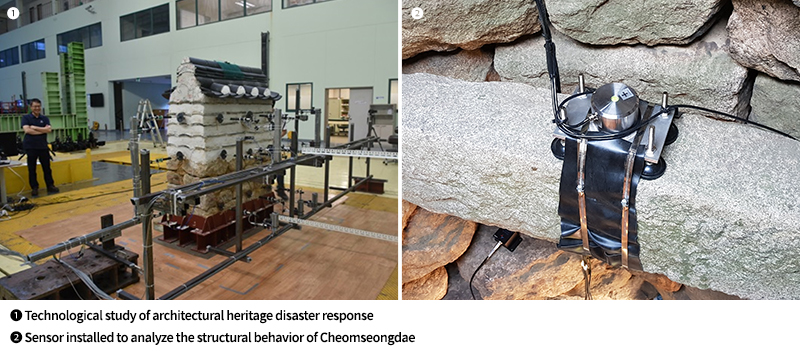

In 2018, the National Research Institute of Cultural Heritage (NRICH)’s Safety and Disaster Prevention Division conducted shaking table tests involving replicas of the traditional outer walls and the Three-story Stone Pagoda at Cheollyongsa Temple Site in Namsan Mountain, Gyeongju, an artifact that sustained damage during the magnitude 5.8 earthquake that occurred in Gyeongju in September 2016. For the tests, traditional walls reproduced according to the Standard Specifications for the Repair of Cultural Heritage Properties, as well as a replica onethird the size of the stone pagoda, were used. Each abutting surface of the pagoda replica was created with unique traits to examine which construction technique was the most earthquake-resistant. As for the walls, in addition to a wall built based on the Specifications, a wall featuring the same inorganic binder used for the Stone Pagoda at Mireuksa Temple Site, Iksan, as well as the reproduction of the wall surrounding the Jungjeongdang Lecture Hall at Dodongseowon Confucian Academy, Dalseong (Treasure No. 350), was used. As for seismic waves, those of the aforementioned earthquake in Gyeongju and of earthquakes in Pohang, as well as those used in the U.S. and Japan for seismic testing, were replicated. These seismic waves also included those of an earthquake with a magnitude of 6.0 or above.
According to the tests, two abutting pagoda elements with the largest contact surface were the least vulnerable to seismic waves. In the case of the walls, none of the tested walls either collapsed or lost their roof tiles. These results led researchers to conclude that Korean stone pagodas and outer walls are highly likely to remain safe from earthquakes as long as they have been built or repaired according to the traditional principles handed down from our ancestors. In the aftermath of the two recent earthquakes, there have been media reports that hanok, or traditional Korean houses, are earthquake-proof and that the geuraengi technique (a traditional stonemasonry technique, where the bottom surface of the upper stone is chiseled in the exact shape of the top surface of the lower stone for a perfect fit) used for Bulguksa Temple’s stonework is a traditional construction technique that resists earthquake damage. Clearly, in traditional wooden structures, the pliability of wood and the continuation from the foundation stone to column to roof tend to reduce the impact of seismic waves. Similarly, the geuraengi technique, which maximizes the contact surface between architectural elements, is used in various parts of traditional wooden buildings, including the point where a wooden column and its foundation stone meet. As such, Korean traditional architecture can be regarded as embodying basic anti-disaster resistance. Now, we are at the stage where we need to verify through experiments how effectively a wooden column shaped using the geuraengi technique (a column whose bottom surface was contoured to resemble the top surface of its foundation) can withstand seismic waves, when compared with an ordinary column.
Utilization of Advanced Sensors and an Online Platform for Constant Safety Management
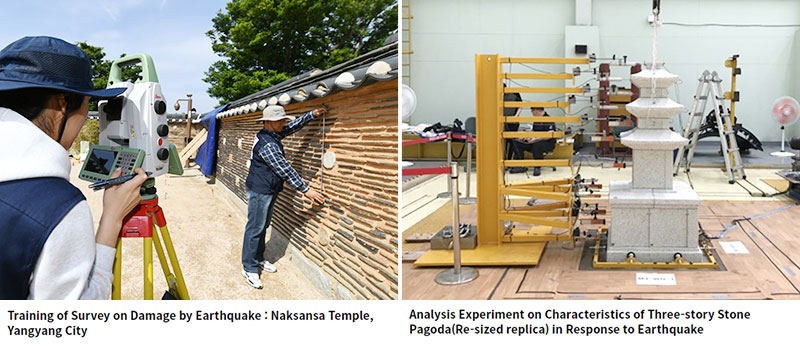

Without an earthquake or other similar disasters, what is most harmful to the structural stability of an architectural cultural property is the aging (e.g. decomposition and breakage) of the property’s materials. To seek out solutions, the Safety and Disaster Prevention Division has begun taking two new measures, in addition to regular on-site inspections by researchers. One is the experimental analysis of the aging characteristics of the materials used in cultural heritage items. The other is the establishment of a measuring and monitoring system to detect deformities occurring in cultural heritage properties.
When analyzing the aging characteristics of a material, the first step is to understand the basic properties of the material. To this end, from 2016 to 2018, our division established and operated a lab at the Jungwon National Research Institute of Cultural Heritage, where our researchers conducted experiments on the material properties, dehydration, strength, deformation, and diverse other aspects of major wood materials used in Korean traditional architecture. In addition to basic experiment equipment (e.g. a thermo-hygrostat system and a dryer), the lab also used a universal testing machine (UTM) to artificially apply tensile and compression forces to materials, as well as laser-type and optical fiber-type sensors to measure different displacements.
Recently, the Fourth Industrial Revolution has become a hot topic even in the field of cultural heritage research. In keeping with such trends, our division made attempts to utilize big data analysis tools and a cloud-based online platform for the safety management of cultural heritage properties. As part of such efforts, in partnership with the National Information Society Agency (NIA), our division established a trial version of a smart cultural heritage management cloud platform in 2018 to improve the safety management of cultural heritage properties. Currently, we are reviewing the applicability and problems inherent in the platform. As for the measuring and monitoring of cultural heritage properties, six architectural cultural heritage sites, including Cheomseongdae Observatory in Gyeongju, have been the target of precision monitoring that utilizes diverse measuring sensors since before 2019. Each property has been separately monitored, with researchers visiting each site, accessing the on-site computer system, and obtaining measurement readings. Such monitoring has been selected in consideration of the surrounding environmental conditions of these cultural heritage sites. One idea recently under consideration is drone-based monitoring of cultural heritage properties and their surroundings located in remote areas.
Keeping Our Cultural Heritage Safer in a Rapidly Changing WorldIn addition to the research on preemptive anti-disaster measures and the experimental analysis of cultural heritage items’ structural stability, the Safety and Disaster Prevention Division has been conducting somewhere between 150 and 200 status surveys annually, chosen from among some 750 architectural cultural heritage properties that are state-designated National Treasures or Treasures. For these field surveys, a team of two to three researchers has been checking each cultural heritage item for minute changes, every three to five years. Furthermore, every year, from one to four times, our researchers carry out safety inspections of some 30 cultural heritage properties as recommended by the Cultural Heritage Committee. For these inspections, instruments, such as an electro-optical distance meter and a crack gauge are utilized. At the same time, for the aforementioned six cultural heritage sites, including Cheomseongdae Observatory in Gyeongju, a dedicated real-time monitoring system utilizing high-precision measurement sensors has been established and is in operation. Moreover, to measure the soundness of wood suspected of pest infestation, a resistograph is also being used.
Cultural heritage is an inheritance from the past. Yet, cultural heritage properties do not need to be preserved using only traditional methods. At the time of its creation, each cultural heritage item must have been the product of the most advanced technologies and tools of the period. What matters to us today is the wholesome preservation of what remains of our cultural heritage. In this regard, the matter of foremost importance is to identify the value of the cultural heritage item in question, recognize that value, and preserve the heritage in the best possible way to showcase the originality of such value. In light of this, all researchers in our division are going to great lengths in cultural heritage sites, research rooms and labs, to figure out better ways to pass on to the next generation our precious cultural heritage in pristine condition.

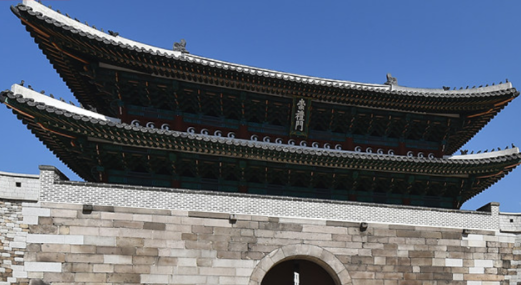
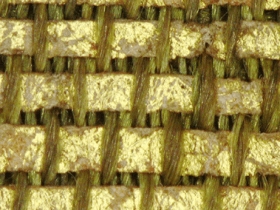

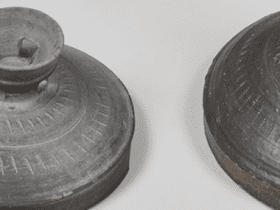
Leave a Reply